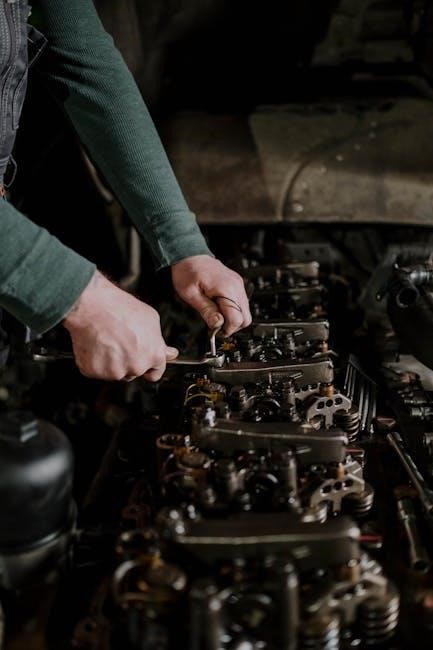A truck manual gearbox is a crucial component enabling precise speed and torque control‚ enhancing fuel efficiency and driver engagement. Despite the industry’s shift toward automatics‚ manual transmissions remain vital for specific applications due to their durability and cost-effectiveness. This section explores their fundamental role and evolving relevance in modern trucking.
1.1 What is a Truck Manual Gearbox?
A truck manual gearbox‚ also known as a manual transmission‚ is a type of transmission system that requires driver input to change gears. It operates through a clutch pedal and gearshift‚ allowing the driver to manually select the appropriate gear ratio for varying driving conditions. This mechanical system provides precise control over torque and speed‚ making it ideal for heavy-duty applications. The gearbox consists of gearsets‚ bearings‚ and synchromesh mechanisms‚ ensuring smooth and efficient power transfer from the engine to the wheels. Unlike automatic transmissions‚ manual gearboxes rely on the driver’s ability to coordinate clutch engagement and gear selection‚ offering a direct connection to the vehicle’s performance. While modern trucks increasingly adopt automatic transmissions‚ manual gearboxes remain popular for their durability‚ cost-effectiveness‚ and driver control in specific scenarios.
1.2 Importance of Manual Gearboxes in Trucks
Manual gearboxes play a vital role in trucks due to their ability to optimize fuel efficiency and performance. They provide drivers with precise control over gear shifts‚ which is essential for navigating challenging terrains and heavy loads. Unlike automatic transmissions‚ manual gearboxes often require less maintenance and are more cost-effective‚ making them a preferred choice for many fleet operators. Additionally‚ the durability of manual transmissions ensures they can withstand the rigors of heavy-duty applications better than their automatic counterparts. While the industry is shifting toward automatics‚ manual gearboxes remain indispensable for specific use cases‚ offering unmatched driver engagement and operational flexibility. Their simplicity and reliability continue to make them a valuable asset in the trucking industry.

Components of a Truck Manual Gearbox
A truck manual gearbox consists of gears‚ bearings‚ shafts‚ and a clutch system. These components work together to enable smooth gear transitions‚ ensuring efficient power delivery and control.
2.1 Key Components of a Manual Gearbox
The essential parts of a manual gearbox include the gear sets‚ which provide different speed ratios‚ and the input shaft‚ connecting to the clutch. The output shaft transmits power to the drivetrain. Bearings ensure smooth operation‚ while synchros facilitate seamless gear shifts. The clutch system disengages power during shifting‚ and the gearbox housing protects internal components. Together‚ these elements enable manual control over speed and torque‚ crucial for heavy-duty applications. Regular maintenance‚ such as fluid checks‚ is vital for longevity. Understanding these components helps in diagnosing issues and performing repairs effectively‚ ensuring optimal gearbox performance.
2.2 How These Components Interact
The interaction of a manual gearbox’s components begins with the driver engaging the clutch‚ which disengages the engine from the transmission. The gearshift is connected to the gear selector‚ moving the fork to engage specific gears on the input shaft. The synchros synchronize gear speeds‚ ensuring smooth shifts. Once a gear is engaged‚ the output shaft transmits power to the drivetrain. The bearings reduce friction‚ allowing gears to rotate smoothly. Proper lubrication is critical for component longevity. This coordinated process enables efficient power transfer‚ allowing drivers to control speed and torque effectively. Regular maintenance‚ such as fluid checks‚ ensures optimal performance and prevents wear. Understanding this interaction is key to diagnosing and addressing potential issues‚ ensuring the gearbox operates reliably under various conditions.

How a Truck Manual Gearbox Works
A truck manual gearbox operates through driver input‚ engaging the clutch to disconnect the engine‚ then shifting gears via the gearshift and synchronizers to transmit power efficiently.
3.1 Basic Principles of a Manual Gearbox
The manual gearbox in trucks relies on mechanical components to transfer power from the engine to the wheels. The driver controls the process by pressing the clutch pedal‚ disconnecting the engine from the transmission. This allows the gearshift to move through the gate‚ selecting the desired gear ratio. Inside the gearbox‚ gears and bearings align to match the selected ratio‚ ensuring smooth power delivery. The clutch then engages‚ reconnecting the engine to the transmission. This system provides precise control over speed and torque‚ essential for hauling heavy loads efficiently. Regular maintenance‚ such as fluid checks and clutch adjustments‚ is crucial for optimal performance and longevity.
3.2 Driver Input and Gear Shifting Techniques
Mastering a truck manual gearbox requires precise driver input‚ including clutch pedal control and gear lever operation. Smooth coordination between the clutch and accelerator prevents wear and tear. Drivers must match engine speed to the desired gear‚ especially during downshifting‚ to maintain control. Listening to engine sounds helps in timing shifts accurately. Proper techniques like feathering the clutch or double-clutching can enhance gear transitions. These skills are essential for efficient operation‚ reducing fatigue and extending gearbox lifespan. Regular practice and adherence to manufacturer guidelines ensure optimal performance and minimize repair needs. As the industry shifts toward automatics‚ mastering these techniques remains vital for drivers relying on manual transmissions.

Types of Manual Gearboxes Used in Trucks
Trucks utilize various manual gearbox types‚ including standard‚ heavy-duty‚ and specialized models. These transmissions cater to different payload requirements‚ with some offering advanced features for efficiency and durability.
4.1 Common Types of Manual Transmissions

Trucks commonly feature manual transmissions like the 6-speed‚ which is prevalent in 4×4 and pickup models. These gearboxes are known for their durability and fuel efficiency. The industry shift toward automatics hasn’t eliminated manual options‚ with models like the Ford F-150 still offering them. Heavy-duty brands such as Eaton and Allison provide robust manual transmissions for commercial use. Specialized manual gearboxes‚ like those designed for construction or off-road tasks‚ are also available. While less common in modern trucks‚ manual transmissions remain popular for their control and cost-effectiveness. Repair manuals for these systems are widely accessible online‚ ensuring maintenance and troubleshooting are manageable. This variety caters to diverse needs‚ from everyday driving to heavy-duty applications.
4.2 Specialized Manual Gearboxes for Heavy-Duty Trucks

Specialized manual gearboxes for heavy-duty trucks are engineered for extreme durability and performance‚ catering to specific industrial needs. Companies like Eaton and Allison produce transmissions designed for construction‚ off-road‚ and high-torque applications. These gearboxes often feature advanced controls‚ such as automated manual transmissions with clutch-assist technology‚ blending manual precision with enhanced efficiency. They are built to withstand the rigors of constant heavy loads and harsh environments. Maintenance and repair guides are readily available‚ ensuring longevity and reliability. These specialized systems remain indispensable for tasks requiring precise control and strength‚ even as the industry trends toward automation. Their robust design and application-specific features make them vital for heavy-duty operations‚ ensuring optimal performance in demanding conditions.

Advantages of Manual Gearboxes in Trucks
Manual gearboxes in trucks offer better fuel efficiency‚ driver control‚ and cost-effectiveness compared to automatics. They are simpler‚ lighter‚ and require less maintenance‚ making them a practical choice.
5.1 Fuel Efficiency and Performance
Manual gearboxes in trucks are known for their superior fuel efficiency and performance. By allowing drivers to control gear shifts precisely‚ they optimize engine speed and torque delivery‚ reducing fuel consumption.
This direct control enhances performance‚ especially in challenging conditions like steep inclines or heavy loads. The mechanical simplicity of manual transmissions also means less energy loss compared to automatics.
Overall‚ manual gearboxes provide a cost-effective solution for fleets seeking to minimize fuel expenses while maintaining reliable performance across various operational demands.
5.2 Cost-Effectiveness and Durability
Manual gearboxes are highly cost-effective and durable‚ making them a preferred choice for many truck operators. Their mechanical simplicity reduces production and repair costs compared to automatic transmissions.
With proper maintenance‚ manual gearboxes can withstand heavy-duty operations and last for years. Regular oil changes and clutch replacements are relatively inexpensive‚ further enhancing their economic appeal.
Their durability also makes them ideal for challenging environments‚ ensuring reliable performance under demanding conditions. This combination of affordability and longevity explains their enduring popularity in the trucking industry.

Maintenance and Repair of a Truck Manual Gearbox
Regular oil changes and component inspections are essential for maintaining a manual gearbox. Repairs often involve replacing worn bearings or synchros‚ ensuring optimal performance and longevity.
6.1 Regular Maintenance Tips
Regular maintenance is crucial for extending the lifespan of a truck manual gearbox. Ensure transmission oil is checked and changed as per the manufacturer’s recommendations to prevent overheating and wear. Inspect the gear oil level regularly and top it up if necessary. Replace the oil filter every 30‚000 to 50‚000 miles to maintain cleanliness. Check for any signs of leakage around the gearbox and seals. Inspect the clutch pedal and linkage for proper alignment and smooth operation. Lubricate moving parts periodically to reduce friction. Refer to service manuals from reliable sources like pdfmanual4trucks.com or Truckmanualshub.Com for specific guidelines tailored to your truck model.
6.2 Common Repair Issues and Solutions
Common repair issues with truck manual gearboxes include gear oil leaks‚ worn-out clutch plates‚ and damaged synchronizers. Leaks often stem from faulty seals or gaskets‚ which should be replaced promptly to avoid further damage. Worn clutch plates can cause difficulty in shifting gears and require replacement. Synchronizer wear may lead to grinding noises during gear changes‚ necessitating professional repair. Regular inspection of gear oil levels and condition can prevent overheating and premature wear. For detailed repair guides‚ consult resources like Truckmanualshub.Com or pdfmanual4trucks.com‚ which offer comprehensive manuals and troubleshooting tips. Always use genuine parts to ensure durability and reliability.

Industry Trends and the Shift Away from Manual Gearboxes
The trucking industry is increasingly favoring automatic transmissions due to improved efficiency and reduced driver fatigue; Companies like Kenworth are limiting manual options‚ reflecting this trend.
7.1 Why the Trucking Industry is Moving Away from Manual Transmissions
The trucking industry is shifting away from manual transmissions due to advancements in automatic and semi-automatic technologies‚ which enhance fuel efficiency‚ reduce driver fatigue‚ and improve safety. Modern fleets prioritize ease of operation‚ as automatics require less driver input‚ allowing focus on road conditions and cargo management. Additionally‚ automatic transmissions reduce training time for new drivers and minimize wear and tear on the vehicle‚ leading to lower maintenance costs. Environmental regulations also favor automatics‚ as they often achieve better fuel economy. Consequently‚ companies like Kenworth are limiting manual options‚ signaling a broader industry trend toward adopting automatic transmissions for their operational and economic benefits.
7.2 The Rise of Automatic and Semi-Automatic Transmissions
The rise of automatic and semi-automatic transmissions in trucks is driven by technological advancements and the demand for improved efficiency. These systems offer smoother gear shifts‚ reduced driver fatigue‚ and better fuel economy compared to manual gearboxes. Automatic transmissions‚ such as torque converter-based systems‚ are increasingly popular for their ease of use and compatibility with modern driving conditions. Semi-automatic transmissions‚ like automated manual transmissions (AMTs)‚ combine the best of both worlds‚ offering manual-like control with automatic shifting convenience. As the trucking industry evolves‚ these transmissions are becoming the preferred choice for many fleets‚ aligning with regulatory requirements for reduced emissions and lower operating costs. Their adoption signals a significant shift toward modernizing trucking operations for enhanced performance and sustainability.

Resources for Truck Manual Gearbox Information
Online platforms like pdfmanual4trucks.com and Truckmanualshub.Com offer free service manuals‚ repair guides‚ and wiring diagrams for various truck models. These resources provide detailed instructions for maintenance and troubleshooting.
8.1 Service Manuals and Repair Guides
Service manuals and repair guides are essential resources for maintaining and fixing truck manual gearboxes. Websites like pdfmanual4trucks.com and Truckmanualshub.Com provide free access to detailed manuals‚ wiring diagrams‚ and fault codes. These documents cover troubleshooting‚ maintenance schedules‚ and step-by-step repair procedures. They are invaluable for mechanics and drivers alike‚ ensuring proper handling of gearbox components. Brands like Scania and Volvo also offer comprehensive manuals tailored to their specific models. These guides help users identify issues‚ replace parts‚ and optimize performance. Regular updates ensure the information stays relevant‚ addressing both common and complex problems. By referring to these manuals‚ users can extend the lifespan of their gearboxes and maintain peak functionality. They are indispensable tools for anyone involved in truck maintenance and repair.
8.2 Online Platforms for Downloading Truck Manuals
Several online platforms offer easy access to truck manual gearbox manuals‚ enabling users to download essential resources. Websites like pdfmanual4trucks.com and Truckmanualshub.Com provide extensive libraries of service manuals‚ wiring diagrams‚ and fault codes. These platforms cater to various truck models‚ including Scania‚ Volvo‚ and Ford‚ ensuring compatibility and relevance. Users can search by specific make‚ model‚ or year to find accurate documentation. Many platforms offer free downloads‚ while others require subscriptions. These resources are vital for mechanics‚ drivers‚ and enthusiasts‚ offering detailed instructions for maintenance‚ repairs‚ and troubleshooting. By leveraging these platforms‚ individuals can access the information needed to keep their truck manual gearboxes in optimal condition‚ ensuring longevity and performance. These online repositories are indispensable for modern truck maintenance and repair practices.
The truck manual gearbox remains a cornerstone of the trucking industry‚ balancing cost-effectiveness and performance. Despite the rise of automatics‚ its durability and simplicity ensure its continued relevance in specific applications.
9.1 Summary of Key Points
A truck manual gearbox is a vital component offering precise control over speed and torque‚ which enhances fuel efficiency and driver engagement. Despite the industry’s shift toward automatic transmissions‚ manual gearboxes remain cost-effective and durable‚ making them suitable for specific applications. Their simplicity in design contributes to lower maintenance costs and longevity. However‚ the increasing demand for automation and reduced driver effort has led to a decline in their popularity. Manuals are still preferred in certain regions and for heavy-duty tasks where driver control is essential. Overall‚ while automatics dominate modern trucks‚ manual gearboxes retain their relevance in niche markets and applications where their unique benefits are valued.
9.2 Future of Manual Gearboxes in the Trucking Industry
The future of manual gearboxes in trucking appears uncertain‚ with a steady decline in popularity due to automation and technological advancements. Many manufacturers‚ like Kenworth‚ are limiting manual transmissions‚ reflecting industry trends. The rise of electric vehicles and autonomous driving further accelerates this shift. However‚ manual gearboxes may persist in niche markets‚ such as heavy-duty or specialized applications‚ where their efficiency‚ driver engagement‚ and cost-effectiveness remain advantageous; Despite this‚ the broader industry is moving toward automatic and semi-automatic transmissions‚ prioritizing ease of use and reduced driver fatigue. As trucking evolves‚ manual gearboxes may become rare‚ but their durability and simplicity ensure they won’t disappear entirely‚ especially in regions or sectors where traditional methods are valued.



